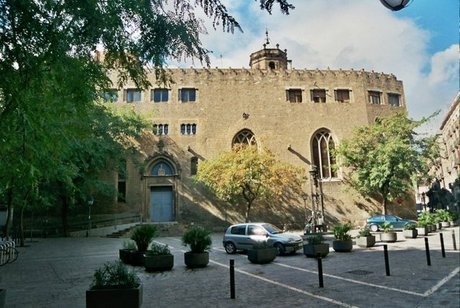Sant Pere
Many of Barcelona’s squares in Ciutat Vella contain astonishing Romanesque landmarks. Time seems to have stood still in the heart of the neighbourhood of Sant Pere, where the church of the ancient convent of Sant Pere de les Puelles still stands. A history dating back centuries marked by renovations which haven’t taken away any of the charm of the original building.
The history of the ancient monastery of Sant Pere de Puelles dates back to 945 AD, the year of its consecration. At that time, it became Barcelona’s first convent of Benedictine nuns. Throughout its history, Sant Pere de les Puelles has experienced many changes in fortune that have transformed the Romanesque building, which was built outside the city walls. The attacks by Arab troops, fires, and the expulsion of its religious community in the 19th century sealed its fate and the nuns moved to a new, permanent site in Sarrià-Sant Gervasi in 1879.
The church has been remodelled and undergone successive changes, and now, all that remains of the original monastery – where the nuns, most of whom were the daughters of the city’s noble families, once lived – is a heavily restored Romanesque church which preserves some relics of the original one. They can be seen in the chapel of the Holy Sacrament. Only one of the two original bell towers survives. It is octagonal in shape and has six bells which can be heard pealing throughout the neighbourhood. The Plaça de Sant Pere of Barcelona, with the imposing presence of the ancient monastery, is one of the most charming spots in the old town, the Ciutat Vella neighbourhood.
Walking out of the Gothic quarter and crossing one street can take you to the entirely different world of the Sant Pere neighbourhood. Here, you can stroll in quiet alleys, you can watch elderly people slowly going for a walk, you can see women chatting on their balconies, while someone on the street pulls a cart with boxes to their destination. Sant Pere is not an area to go for amazing architecture, but it is all the more interesting just because of its complete normality and lack of pretense.
While the sun struggles to get a foot on the ground in the alleys, life goes on anyway, albeit slowly and in an undisturbed way. Walking in Sant Pere, it is sometimes difficult to realize that you are really not far away from the hustle and bustle of downtown Barcelona. But of course, that is the charm of this old neighbourhood. One of the most interesting streets is the Sant Pere mes Baix, where small shops of all kinds can be found, and one of the oldest pharmacies in the city, founded in the 15th century.
There are some remarkable buildings though. First of all, the Palau de la Música Catalana, designed by Domènech i Montaner. Built in the early 20th century, it is yet another example of the abundance and cheerfulness of Barcelona architecture. Then, on the other side of Sant Pere, is the new market of Santa Caterina, a unique building with a clean and spacious market inside. Apart from these buildings, the real attraction of Sant Pere is just to stroll around the small alleys, discover tiny squares, a church, and life as it has been going on mostly unchanged for a long time.
Sant Pere de les Puelles (St. Peter of the Novices) is one of the oldest medieval churches in Barcelona and has been destroyed and restored so many times that there is little left to see except the beautiful stained-glass window that allows illumination of the stark interior. The word puelles is from the Latin puella (girl)—the convent here was known for the beauty and nobility of its young women, and was the setting for some of medieval Barcelona's most tragic stories of impossible love. Legend has it that the puellae, when threatened with rape and murder by the invading Moors under Al-Mansur in 986, disfigured themselves by slicing off their own ears and noses in an (apparently futile) attempt to save themselves.
The church forms part of the premises of the monastery of Benedictine nuns, which was founded in the mid-10th century and subsisted as it was until the 19th century. The church, which dates from the pre-Romanesque period, preserves part of the 10th century Greek cross and Corinthian capitals. The small bell-tower, called Los Pájaros, is also from the Romanesque period. The Plaza de Sant Pere is presided over by a Neoclassical wrought iron fountain.
The site was originally a chapel dedicated to the bishop and martyr S. Sadurni that had been built in 801 to serve the spiritual needs of Charlemagne's troop. A group of young daughters of noble families retired to this chapel in the late 9th century to form a community dedicated to the contemplative life. The community did not have a rule until 945, when Countess Riquilda of Barcelona (wife of Count Sunyer) reorganized the community under the Rule of S. Benedict. It was at that time that both the monastery and a new church were built. Al-Mansur's troops destroyed all of the original buildings and either killed or sold into slavery all of the nuns during the 985 raid on Barcelona, but Count Borrell II and Bishop Vivas of Barcelona re-founded the community the next year. You can get there via direct flight to Barcelona or to Girona, Reus or Lleida–Alguaire.
Sant Pere is one of the places people can easily miss, while traveling in Barcelona. Next to the splendid Gothic Quarter, Sant Pere offers sightseeing and one of a kind taste of the medieval Barcelona. Spend some time in the neighbourhood when you go to Spain. The Gothic Quarter is famous for its old looking hotels, where you can book a reservation and spend the night. From there, Sant Pere is just a few steps away.




